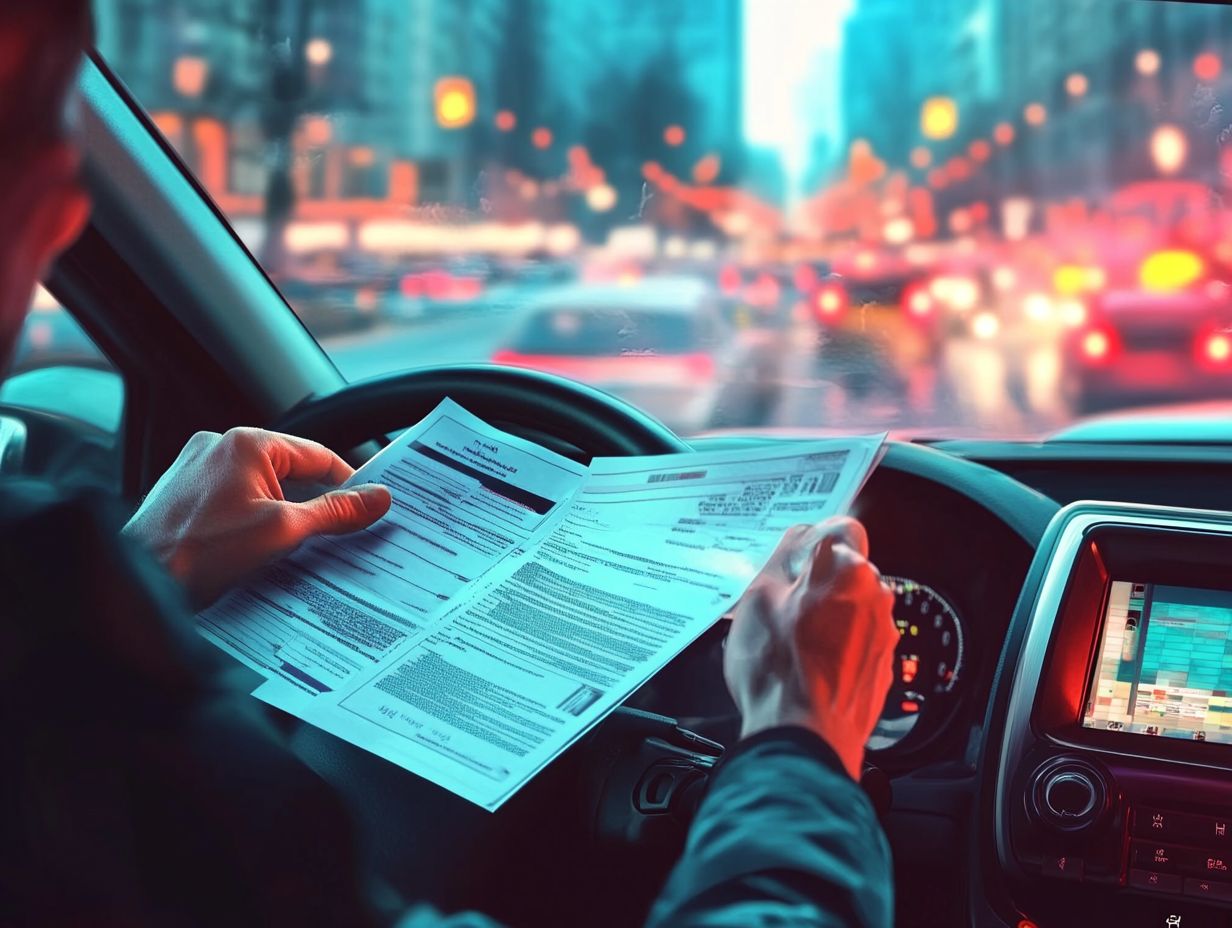5 Common Mistakes High-Risk Drivers Make with Insurance
Navigating the world of auto insurance can be particularly challenging for high-risk drivers like you. Mistakes in this area can lead to higher premiums and limited coverage options, ultimately affecting your financial health and peace of mind.
This article delves into five common errors that high-risk drivers often encounter, from not disclosing accurate information to overlooking valuable discounts.
It also examines how insurance companies assess risk, the various types of coverage available, and effective strategies for improving both driving records and insurance rates.
Continue reading to uncover how to make informed decisions and secure the best insurance tailored to your needs.
Contents
- Key Takeaways:
- 1. Not Disclosing Accurate Information to the Insurance Company
- 2. Failing to Understand the Coverage Options
- 3. Not Shopping Around for the Best Rates
- 4. Not Taking Advantage of Discounts
- 5. Not Re-Evaluating Coverage Needs Regularly
- What Is Considered a High-Risk Driver?
- How Do Insurance Companies Determine Rates for High-Risk Drivers?
- What Are the Different Types of Coverage Available for High-Risk Drivers?
- What Are Some Ways to Lower Insurance Rates for High-Risk Drivers?
- What Are the Consequences of Not Having Adequate Insurance Coverage as a High-Risk Driver?
- How Can High-Risk Drivers Improve Their Driving Record and Insurance Rates?
- Frequently Asked Questions
- What mistakes do high-risk drivers often make with insurance?
- Why is it important for high-risk drivers to disclose all information to their insurance company?
- How can high-risk drivers avoid paying higher insurance rates?
- What are some common discounts available for high-risk drivers?
- What happens if a high-risk driver does not maintain a good driving record?
- Why is it important for high-risk drivers to purchase enough coverage?
Key Takeaways:
Here are some essential tips to keep in mind:
Accurate disclosure is key. Not providing accurate information to your insurance company can result in denied coverage or cancellation of your policy.
Understand your coverage options. High-risk drivers may need additional coverage options, and it’s important to know the truth behind 5 myths about high-risk driver insurance to protect themselves and their assets.
Shop around for the best rates. Don’t settle for the first insurance company you come across. Compare rates and coverage options from different companies to find the best fit for your needs.
1. Not Disclosing Accurate Information to the Insurance Company
Not disclosing accurate information to your insurance company is a critical mistake that can carry serious implications for your car insurance policy. This error can affect everything from your insurance premiums to your claims history, particularly if you’re already considered a high-risk driver. To avoid such pitfalls, be aware of the 7 biggest mistakes in auto insurance that many make.
When filling out your auto insurance application, transparency is absolutely essential. Even minor inaccuracies can lead to devastating consequences. For instance, neglecting to mention a previous accident might result in denied claims when you really need that coverage, leaving you financially exposed.
If you underestimate the number of miles you drive each year or misrepresent your vehicle’s safety features, you could end up facing higher rates or even policy cancellations. To avoid these pitfalls, consider the 5 insurance tips for new high-risk drivers. Common oversights include failing to report driving violations or not mentioning that your car is primarily parked in a high-crime area.
By ensuring that all details you provide are accurate, you not only protect yourself financially but also cultivate a smoother relationship with your insurance provider.
2. Failing to Understand the Coverage Options
Failing to understand the various coverage options available in auto insurance can leave you vulnerable. Without a clear understanding of the differences between collision coverage and comprehensive coverage, you risk compromising your financial security in the event of a vehicle accident.
Collision coverage helps pay for damage to your car after an accident. It is essential for anyone who frequently navigates busy roads. On the flip side, comprehensive coverage protects against theft or damage from events like storms, vandalism, or natural disasters events that can often take you by surprise.
By gaining a solid understanding of these options, you can significantly impact both your insurance rates and policy selection, leading to smarter financial decisions. Navigating the complexities of insurance policies requires research and comparison of coverage limits, deductibles, and applicable discounts, giving you the power to secure the best possible deal while ensuring robust protection for your vehicle.
3. Not Shopping Around for the Best Rates
Not taking the time to shop around for the best rates is a common oversight that can lead to common mistakes that increase your premiums and unnecessarily high insurance costs.
Many drivers miss out on exploring different insurance options. This oversight can cost young drivers, drivers with a history of accidents or violations, or those with low credit scores, who may already be dealing with steeper premiums. To avoid this pitfall, it’s crucial to learn about the mistakes to avoid when comparing auto insurance.
To ensure you have comprehensive coverage, which is the financial protection your insurance provides, without emptying your wallet, it s essential to gather quotes from multiple providers.
Start by assessing your personal needs and driving habits. Then, utilize online comparison tools that make it easy to evaluate different policies and rates.
If you’re a young driver, keep an eye out for discounts for good grades or the completion of driving courses. High-risk drivers should consider policies specifically tailored to their unique situations. If credit scores are a concern, getting quotes from insurers that focus less on your record of borrowing and repaying money can make a huge difference in your savings.
By leveraging available resources and considering a range of insurance options, you can find a policy that fits your budget while offering adequate protection.
4. Not Taking Advantage of Discounts

Failing to take advantage of available insurance discounts can lead to higher car insurance costs, as many drivers often overlook potential savings. Factors such as a clean driving record, low mileage, or even being a young driver who has completed a driver’s education program can all lead to discounts.
In fact, various types of insurance discounts can help you ease these expenses. For instance, if you have multiple vehicles, multi-driver discounts can be a game changer, allowing families to reduce overall premiums by combining them under one policy.
Similarly, low-mileage discounts reward those who drive less frequently by acknowledging their reduced risk profile. Young drivers will be pleased to discover that completing a driver’s education course not only sharpens their skills but also qualifies them for discounts, making insurance premiums much more manageable.
Consulting with insurance agents is always a savvy move. They can provide personalized recommendations that maximize your potential savings and ensure you’re well-informed about all the options at your disposal.
5. Not Re-Evaluating Coverage Needs Regularly
Not regularly re-evaluating your coverage needs can leave you with inadequate insurance, putting you at financial risk especially as your vehicle ownership situation evolves or if you decide to invest in a high-end vehicle that comes with higher maintenance costs.
Without consistent assessments, you might overlook crucial factors that influence your insurance costs and coverage. Changes in your driving habits, shifts in household composition, or new additions to your vehicle fleet can all have significant implications. For example, bringing a newly licensed teen driver into the mix or opting for a more eco-friendly car can dramatically affect your premiums.
To ensure you have the protection you need while securing optimal rates, it s wise to conduct an annual review of all your policies. Keeping a detailed inventory of any changes in your circumstances is essential. Consulting with an insurance professional can clarify necessary adjustments and reveal potential discounts, ultimately safeguarding your financial interests more effectively.
What Is Considered a High-Risk Driver?
A high-risk driver is often defined by a track record of risky driving behaviors. This includes frequent accidents, a poor claims history, and a pattern of driving mistakes. These factors can severely impact your insurance rates and the availability of comprehensive coverage.
Insurance companies evaluate various elements when determining your risk level. A history of multiple traffic violations can raise concerns. This includes speeding tickets and DUIs.
If you tend to file numerous claims, you might find yourself labeled as high-risk. This classification often leads to steeper premiums and restricts your ability to secure favorable insurance policies in the future.
Therefore, it’s essential to actively focus on improving your driving habits and maintaining a clean record. By doing so, you can gradually regain access to more competitive insurance rates, paving the way for better options down the road.
How Do Insurance Companies Determine Rates for High-Risk Drivers?
Insurance companies assess rates for high-risk drivers by examining various factors. These include your driving record, the frequency of vehicle accidents, and your claims history. Together, these elements create a comprehensive view of your risk profile.
These factors shape an insurer s decision-making process regarding premium pricing. A history of multiple accidents may signal a higher likelihood of future incidents. This can prompt insurers to impose steeper rates to mitigate potential losses.
Risky driving behaviors like speeding and DUIs are significant red flags that can influence your costs. Insurers utilize statistical data and draw insights from industry standards and historical trends to evaluate how similar drivers have affected their financial outcomes.
This data-driven strategy helps ensure your rates reflect your unique circumstances while aligning with broader market practices.
What Are the Different Types of Coverage Available for High-Risk Drivers?

High-risk drivers have access to a range of insurance coverage options, including collision and comprehensive coverage. However, your choices might be more limited compared to those of low-risk drivers due to higher premiums and specific underwriting practices.
Collision coverage is essential, especially in the event of an accident. It ensures that damages to your vehicle are covered, regardless of who is at fault. This is particularly crucial if you have a history of incidents on the road.
Comprehensive coverage goes beyond collisions, providing financial protection against theft, vandalism, or even natural disasters. For someone in your position, these coverages could be vital in alleviating potentially overwhelming expenses.
Be aware! The options available to you can differ greatly from standard policies. Insurers often view you as a higher risk, assessing factors such as your driving record, location, and type of vehicle to determine eligibility and rates.
What Are Some Ways to Lower Insurance Rates for High-Risk Drivers?
High-risk drivers have strategies at their disposal to reduce insurance rates. Consider improving your driving record, maintaining a clean claims history, and utilizing devices that track your driving to showcase your responsible habits.
By embracing safe driving practices such as obeying speed limits, avoiding distractions, and staying attentive to road conditions you actively enhance your overall safety on the road. Implementing tracking devices not only gives you real-time feedback on your driving habits but can also lead to significant discounts based on your safe driving performance.
Regularly communicating with your insurance agent can yield personalized advice tailored to your unique situation. This can help you uncover specific discounts or programs that may apply to you. By taking these actionable steps, you not only work to mitigate your insurance costs but also contribute to a culture of safety, benefiting everyone sharing the road.
What Are the Consequences of Not Having Adequate Insurance Coverage as a High-Risk Driver?
Lacking proper insurance can lead to severe financial issues, especially in the event of a vehicle accident. Insufficient coverage may leave you vulnerable to significant out-of-pocket expenses.
Consider a scenario where you are involved in a collision that results in extensive property damage and injuries to others. Without proper coverage, you could find yourself liable for medical bills and repairs that far exceed your policy limits. This financial strain can quickly deplete your savings and even push you toward bankruptcy.
In some states, laws mandate a minimum level of liability insurance for drivers. Yet, many high-risk individuals cut corners on these essentials to save a few dollars. This gamble can backfire dramatically, underscoring the undeniable importance of strong insurance plans. They can serve as a critical safety net in those unfortunate moments when you need it most.
How Can High-Risk Drivers Improve Their Driving Record and Insurance Rates?
High-risk drivers like you can enhance your driving record and lower your insurance rates by participating in driver s education programs, opting for vehicles equipped with advanced safety features, and consistently practicing safe driving techniques.
Engaging in educational courses refreshes your understanding of traffic laws and helps you develop safer driving habits. Choosing vehicles that come with modern safety technologies like automatic braking and blind-spot monitors can drastically reduce your chances of accidents. Consistent practice behind the wheel, combined with mindful driving, reinforces these essential skills over time.
Commit to these strategies to pave the way for safer driving and lower insurance costs.
Check out the video above to learn more about safe driving!
Frequently Asked Questions

What mistakes do high-risk drivers often make with insurance?
Some common mistakes high-risk drivers make include not disclosing all information to their insurance company, failing to shop around for the best rates, missing out on available discounts, not maintaining a good driving record, and not purchasing enough coverage.
Why is it important for high-risk drivers to disclose all information to their insurance company?
Being open with your insurance company can save you money! Your driving history and risk level directly affect your insurance rates. Not disclosing all information could result in higher rates or even insurance denial.
How can high-risk drivers avoid paying higher insurance rates?
High-risk drivers can avoid paying higher insurance rates by shopping around for the best options, taking advantage of available discounts, maintaining a good driving record, and following tips for managing your high-risk driver insurance to purchase enough coverage to protect themselves and their vehicle.
What are some common discounts available for high-risk drivers?
Some common discounts include safe driver discounts, multi-policy discounts, and good student discounts. It s important for high-risk drivers to ask their insurance company about available discounts to help lower their rates.
What happens if a high-risk driver does not maintain a good driving record?
If a high-risk driver does not maintain a good driving record, they may face higher insurance rates or even cancellation of their policy. It’s crucial for high-risk drivers to practice safe driving habits and consider 5 ways to compare insurance to avoid further increases in their insurance costs.
Why is it important for high-risk drivers to purchase enough coverage?
It s crucial for high-risk drivers to purchase enough coverage because they are already considered high-risk and may have a higher chance of getting into accidents. Having sufficient coverage can protect them from potential financial losses and provide peace of mind on the road.







